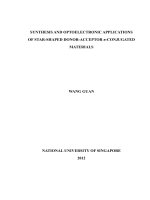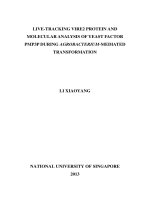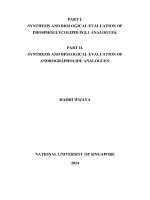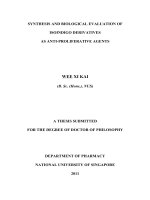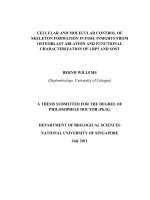Synthesis and molecular assemblies of d10 metal complexes bearing 9, 10 disubstituted anthracene ligand
Bạn đang xem bản rút gọn của tài liệu. Xem và tải ngay bản đầy đủ của tài liệu tại đây (5.52 MB, 246 trang )
Part I. Synthesis and Molecular Assemblies of d
10
Metal
Complexes Bearing 9, 10-Disubstituted
Anthracene Ligand
Part II. Synthesis and Spectroscopic Studies of
Heterobimetallic Platinum(II)-acetylide and
Platinum(0)-acetylene Complexes
ZHANG KE
(B.Sci., Beijing University)
A THESIS SUBMITTED
FOR THE DEGREE OF PHD OF SCIENCE
DEPARTMENT OF CHEMISTRY
NATIONAL UNIVERSITY OF SINGAPORE
2006
i
Acknowledgement
This thesis is a result of four years work whereby I have been accompanied and
supported by many people. It is a pleasant aspect that I have now the opportunity to
express my gratitude for all of them.
The first person I would like to thank is my supervisor Dr. Yip, Hon Kay John, who has
provided me continuous care and guidance on my research work. His overly enthusiasm
on research has made a deep impression on me. Not only the knowledge but also the
scientific attitude, which I learned from him, will be great fortune to me in my future
career and life.
I would like to thank the colleagues in our research group: Mr. Lin Ronger, Dr. Wu
Jianguo, Mr. Hu Jian, Dr. Xu Huan and Miss. Wang Yuanyuan. From all of them, I have
received great help on my experiments and valuable discussion. My special thanks are
given to Miss. Tan Geok Kheng and Prof. Koh Lip Lin for their assistance on crystal
structure analysis. I appreciate Dr. Wang Kwok-Yin for his assistance on electrochemical
measurements of a series of my complexes. I also thank Dr. Leong Weng Kee for his
providing me some of the starting materials. It is my pleasure to give my thanks to all the
staffs in the Chemical, Molecular and Materials Analysis Centre (CMMAC) at the
Department of Chemistry in National University of Singapore for their assistance on
characterization of my compounds.
I want to show my acknowledgement to the National University of Singapore for the
scholarship to pursue my Ph. D. degree.
Finally, I am indebted to my beloved parents and wife. Their infinite encouragement
endowed me with confidence to complete this thesis.
ii
Table of Contents
Acknowledgements……………………………………………………………………… i
Table of Contents………………………………………………………………… ii
List of Abbreviations…………………………………………………………………….v
Summary…………………………………………………………………………………vi
Part I. Synthesis and Molecular Assemblies of d
10
Metal Complexes
Bearing 9, 10-Disubstituted Anthracene Ligand
Chapter 1. Roles of Anthracene Unit in Inorganic Chemistry
1.1 A luminophore for chemosensors…………………………………………………… 3
1.2 -coordinating to metal cations……………………………………………………… 3
1.3 A bridging unit in crystal engineering……………………………………………… 4
1.4 Phosphorus-substituted anthracenes………………………………………………… 5
1.5 Use of the anthracene unit in our group……………………………………………….6
1.6 Objectives…………………………………………………………………………… 9
Chapter 2. Molecular Assemblies of Au
I
Complexes with 9, 10-
Bis(diphenylphosphino)anthracene Ligand
2.1 Introduction………………………………………………………………………… 11
2.1.1 Au-Au interaction…………………………………………………………… 11
2.1.2 - interaction………………………………………………………………….13
2.1.3 Objectives…………………………………………………………………… 15
2.2 Results and discussion……………………………………………………………….16
2.2.1 Synthesis and characterization…………………………………………………16
2.2.2 Crystal structures………………………………………………………………18
2.2.3 Electronic absorption and emission spectroscopy…………………………… 34
2.3 Conclusions………………………………………………………………………… 41
2.4 Experimental section…………………………………………………………………42
Chapter 3. First Examples of Au
I
-X-Ag
I
Halonium Cations
iii
3.1 Introduction…………………………………………………………………………. 45
3.2 Objectives……………………………………………………………………………46
3.3 Results and discussion……………………………………………………………….47
3.4 Conclusions………………………………………………………………………… 51
3.5 Experimental section…………………………………………………………………52
Chapter 4. Systhesis, Structures and Electronic Spectroscopy of
d
10
Metal Complexes with 9, 10-Anthracenedithiol Ligand
4.1 Introduction………………………………………………………………………… 55
4.2 Objectives……………………………………………………………………………56
4.3 Results and discussion……………………………………………………………….57
4.3.1 Synthesis and crystal structures……………………………………………… 57
4.3.2 Electronic absorption and emission spectroscopy…………………………… 65
4.4 Conclusions………………………………………………………………………… 68
4.5 Experimetal section………………………………………………………………… 69
Part II. Synthesis and Spectroscopic Studies of Heterobimetallic Platinum(II)-
acetylide and Platinum(0)-acetylene Complexes
Chapter 5. Introduction on Metal Acetylide/Acetylene Complexes of
Electrochemical and Photophysical Properties
5.1 Mixed-valence complexes………………………………………………………… 75
5.2 CC based bridges in mediating electronic communication……………………… 79
5.3 Photophysical properties…………………………………………………………… 82
5.4 Objectives……………………………………………………………………………84
Chapter 6. Synthesis and Electrochemical Studies of Heterobimetallic
Platinum(II) Ferrocenylacetylide Complexes
6.1 Introduction………………………………………………………………………… 89
6.2 Results and discussion……………………………………………………………….89
iv
6.2.1 Synthesis and characterization…………………………………………………90
6.2.2 Crystal structures………………………………………………………………95
6.2.3 Electronic absorption spectroscopy………………………………………… 106
6.2.4 Electrochemistry…………………………………………………………… 109
6.3 Conclusions…………………………………………………………………………117
6.4 Experimental section……………………………………………………………… 118
Chapter 7. Synthesis and Photophysical Studies of a Series of
Platinum(0)-acetylene Complexes
7.1 Introduction…………………………………………………………………………126
7.2 Results and discussion…………………………………………………………… 128
7.2.1 Synthesis and characterization……………………………………………… 128
7.2.2 Crystal structures…………………………………………………………… 130
7.2.3 Electronic spectroscopy………………………………………………………134
7.3 Conclusions…………………………………………………………………………144
7.4 Experimental section……………………………………………………………… 145
Physical Measurements …………………………………………………………… 149
References…………………………………………………………………………… 153
Publications……………………………………………………………………………175
Appendices…………………………………………………………………………….176
v
List of Abbreviations
AnSSAn di-9-anthryl disulfide
bipy 4, 4’-bipyridine
t
Bu
2
bpy 4, 4-di-tert-butyl-2, 2-bipyridine
COD 1, 5-cyclooctadiene
dcypm bis(dicyclohexylphosphino)methane
dmpm 1, 2-bis(dimethylphosphino)methane
dppf 1, 1-bis(diphenylphosphino)ferrocene
dppm bis(diphenylphosphino)methane
dppp 1, 3-bis(diphenylphosphino)propane
Fc ferrocenyl
HOMO highest occupied molecular obital
H
2
SAnS 9, 10-anthracenedithiol
LMCT ligand-metal charge-transfer
LUMO lowest unoccupied molecular obital
MLCT metal-ligand charge-transfer
NS
2
2-
1, 8-naphthalenedithiolate
NLO nonlinear optical
OTf
-
triflate anion
PAnP 9, 10-bis(diphenylphosphino)anthracene
SAnS
2-
9, 10-anthracenedithiolate
S-tmhd thiolate of 5-mercapto-2,2,6,6-tetramethyl-4-hepten-3-one
TBAH tetrabutylammonium hexafluorophosphate
vi
Summary
Group 10/11 transition metal complexes are of considerable interest due to their
structural diversities and great potential for developing novel materials of molecular scale
in various fields such as optical, electronic and medical materials. This thesis consists of
two parts of work on the synthesis and characterization of metal complexes of these two
groups. The objective of the first part of work was to develop d
10
complexes of
interesting structural properties by utilizing metal-metal and/or - interactions for
assembling molecules. In the second part, to search for novel molecules of electronic and
optical properties, spectroscopy of a series of heterobimetallic platinum(II)-acetylide and
platinum(0)-acetylene complexes were studied.
In the first part of work, Au
I
diphosphine complexes formulated as (-PAnP)(AuX)
2
(PAnP: 9, 10-bis-diphenylphosphinoanthracene; X: Cl(1), Br(2), I(3), NO
3
(4), -CCPh(5),
-CCC
14
H
9
(6)) were prepared and structurally characterized by X-ray diffraction analysis.
Molecules in crystals of 1·CH
2
Cl
2
, 3·CH
2
Cl
2
, 4·0.5Et
2
O and 5·THF form dimers via both
Au-Au and - interactions (between anthracene units), whereas those in 1·0.5Et
2
O,
2·Et
2
O and 2·2CH
2
Cl
2
dimerize only through the latter. Intermolecular edge-to-face -
interactions were observed in 6·0.75CH
2
Cl
2
to dominate over Au-Au interactions, face-
to-face and off-set - interactions. All these complexes show strong ligand-centered
fluorescence. Slow diffusion of THF solution of AgSbF
6
into CH
2
Cl
2
solution of
complexes 1 or 2 gives rise to the formation of novel Au
I
-X-Ag
I
halonium complexes
({[(-PAnP)(AuCl)
2
]
2
Ag}
+
SbF
6
-
(7) or {[(-PAnP)(AuBr)
2
]
2
Ag}
+
SbF
6
-
(8)), structures of
which are stabilized by the collective actions of Ag-X and Au-Ag and - interactions.
Reaction of 9, 10-anthracenedithiol H
2
SAnS with different starting materials ([Cu
2
(-
vii
dppm)
2
(CH
3
CN)
2
](PF
6
)
2
, [Ag
2
(-dppm)
2
](ClO
4
)
2
and PPh
3
AuCl) (dppm: bis-
diphenylphosphinomethane) formed three different d
10
metal thiolates: [(Cu
2
(
2
-
dppm)
2
)
2
(
2
-
2
-SAnS)](PF
6
)
2
(9), [(Ag
2
(
2
-dppm)
2
)
2
(
2
-
2
-SAnS)](ClO
4
)
2
(10) and
(Ph
3
PAu)
2
(-SAnS-SAnS) (11). The anthracene unit plays a key role in stabilizing the
structures of these complexes by forming - interactions. The ligand H
2
SAnS and
complexes 9-11 all show intense ligand-centered emissions (* and n*) in degassed
solution.
In the second part of work, Pt
II
-acetylide complexes formulated as trans-(Fc-CC-
)
2
Pt(-dppm)
2
M(L) (Fc: ferrocenyl; M(L): nothing(12), Au(ClO
4
)(13), Ag(NO
3
)(14),
Cu(PF
6
)(15), Hg(Cl
2
)(16), Rh(CO)(PF
6
)(17), W(CO)
3
(18), Mo(CO)
3
(19)) were
synthesized. Crystal structure results show the presence of intramolecular PtM
interaction in 13-19. The heterogeneous metal atom M also coordinates to one or both
carbon atoms of one of the CC bonds attached on Pt in 15, 17, 18 and 19. UV-visible
spectroscopic studies show that metal-metal interactions exist in solution for 13-17. The
voltammetric data show that while the electronic communications in 13 and 14 are as
poor as that in mononuclear complex trans-Pt(CCFc)
2
(PPh
2
Me)
2
(20), PtHg
interaction in 16 can enhance electronic communication along the CC-Pt-CC bridge.
In addition, electronic spectroscopic properties of a series of platinum(0)-acetylene
complexes (Pt(PPh
3
)
2
(PhC
2
Ph) (21), Pt(dppp)(PhC
2
Ph) (22), Pt(PPh
3
)
2
(PhC
4
Ph) (23),
Pt(dppp)(PhC
4
Ph) (24), (Pt(dppp))
2
(PhC
4
Ph) (25), Pt(dppp)(CH
3
C
4
CH
3
) (26) and
(Pt(dppp))
2
(CH
3
C
4
CH
3
) (27)) (dppp: 1, 3-bis(diphenylphino)propane) were investigated
in the second part of work. All these complexes show interesting MLCT
phosphorescence in both solid state and frozen solution.
1
Part I.
Synthesis and Molecular Assemblies of d
10
Metal Complexes
Bearing 9, 10-Disubstituted Anthracene Ligand
2
Chapter 1
Roles of Anthracene Unit in Inorganic Chemistry
3
For many years the anthracene unit has attracted great attention from both organic and
inorganic chemists, as anthracene derivatives play an important role in designing of
luminescent materials
1
both in solutions and in the solid state, for example, for phosphors
and lasers.
2
The large delocalization of electrons in the aromatic plane endows these
compounds with rich photophysics and photochemistry.
1.1 A luminophore for chemosensors
As a luminophore, an anthracene unit has been introduced into chemosensors designed
either to detect alkali, alkaline-earth,
3
transition metal cations
4
or, more recently, even
anions
5
like halides, acetate and dihydrogenphosphate.
6
The basic strategy in the
construction of these sensor molecules is to substitute the anthracene moiety in the 9-
position or 9- and 10- positions with remote chelating groups (e. g. a crown ether group)
that are capable of trapping ions by means of hydrogen bonds or electrostatic
interactions with neutral or positively charged sensor molecules.
7
Some transition metal
complexes synthesized by this method have been found to behave like logic gates by
switching the fluorescence of anthracene moiety on/off upon changing the oxidation
state of the metal center, as the oxidation state of the metal determines whether there is an
energy/electron transfer from the photoexcited state of the luminophore to the metal to
quench the emission (an example system is illustrated in Scheme 1.1).
8
1.2 -coordinating to metal cations
Besides serving as a luminophore, the anthracene unit itself can also coordinate to metal
cations through an
6
-coordination mode. Novel phosphine molecule sensors have been
synthesized in this strategy recently.
9
As illustrated in Scheme 1.2, an emissive
4
CH
2
N
S
S
S
Cu
I
no energy transfer
h
h'
emissive
CH
2
N
S
S
S
Cu
II
energy transfer
h
nonemissive
oxidizing
reducing
anthraceno-diphosphine ligand L reacted with a d
10
metal cation M
+
to give the
nonemissive
6
complex LM
+
, which could further react with a tertiary phosphine
forming complex LMP
+
to switch on the fluorescence by breaking the -coordination
between the anthracene unit and the metal.
N
N
PPh
2
Ph
2
P
N
N
PPh
2
PPh
2
M
N
N
PPh
2
PPh
2
M
N
N
PPh
2
PPh
2
M
PR
3
M
+
PR
3
L
LM
+
(nonemissive) intermediate
LMP
+
(emissive)
+
+
+
M = Cu, Ag or Au; PR
3
= P(n-Bu)
3
, HPPh
2
or PPh
3
1.3 A bridging unit in crystal engineering
Scheme 1.1
. An example system mimicing a logic
gate using the anthracene unit as a luminophore
Sc
heme 1.2
. A series of -coordination complexes of an anthracene-
containing ligand
5
9, 10-Disubstitued anthracene derivatives are important building blocks in crystal
engineering.
10
For instance, recently Mirkin and co-workers have used a designed
anthracene-containing bidentate ligand to synthesize a metallocyclophane which could
trap an aromatic molecule to form a triple-layered complex with novel photophysical
properties.
10d
The synthetic strategy of this system is shown in Scheme 1.3.
OO PPh
2
Ph
2
P
OO PPh
2
Ph
2
P
Rh
Rh
OO
OO
Ph
2
PPPh
2
PPh
2
Ph
2
P
RhRh
NCCH
3
NCCH
3
H
3
CCN
H
3
CCN
CH
3
CN
2+
2BF
4
-
2+
2BF
4
-
OO
OO
PPh
2
PPh
2
PPh
2
PPh
2
Rh Rh NCCH
3
H
3
CCN
R
2+
2BF
4
-
R
1 eq.
R
=
NCCN
NCCN
or
1.4 Phosphorus-substituted anthracenes
While there are many reports describing oxygen-,
10a, c, d,
11
nitrogen-
12
and silicon-
substituted
13
anthracene derivatives, relatively few studies have been reported on the
phosphorus-substituted anthracenes. Schmutzler and co-workers synthesized the first
Scheme 1.3
. Construction of a triple-
layered metallocyclophane
system using anthracene moieties as key bridging units
6
monophosphorus derivative substituted in the 9-position,
14
and subsequently its
properties as a ligand for d-block metals were investigated.
15
1, 8-
Bis(diphenylphosphino)anthracene serves as a neutral chelating donor ligand in transition
metal chemistry.
16
More recently, Kubiak and co-workers has synthesized the ligand {1-
(9-anthracene)phosphirane}, and investigated the structural properties of its platinum(II)
complexes (Figure 1.1).
17
While the molecular structure of complexes A and B are
dominated by intramolecular -stacking between the anthracene rings, that of complex C
shows significant intermolecular -stacking between anthracene rings of two adjacent
molecules.
P
P
Pt
Cl
Cl
P
P
Pt
S
S
CN
CN
P
P
Pt
S
S
CO
2
Et
CO
2
Et
P
P
Pt
S
S
NC
NC
A
B
C
1.5 Use of the anthracene unit in our group
Figure 1.1
. Structures of three platinum(II) complexe
s of the
ligand {1-(9-anthracene)phosphirane}
7
However, to our knowledge, the coordination chemistry of diphosphorus-substituted
anthracenes at 9- and 10-positions has not been studied yet. Therefore, the ligand 9, 10-
bis(diphenylphosphino)anthracene (PAnP) has been synthesized in our group and utilized
as a building block in crystal engineering of d
10
metal complexes. The preparation of the
ligand is shown in
Scheme 1.4
. Treatment of PAnP with one equivalent of Au
I
ions
Br
Br
Li
Li
PPh
2
PPh
2
2 eq. n-BuLi, ether
ice bath
2 eq. Ph
2
PCl
r.t.
PAnP
produced a fluorescent trinuclear gold ring [Au
3
(-PAnP)
3
(ClO
4
)](ClO
4
)
2
(
Figure
1.2
) that has structure and fluxionality reminiscent of cyclohexane, while the reaction
Scheme 1.4
. Synthesis of the ligand PAnP
Ph
2
P
PPh
2
Ph
2
P
Ph
2
P
PPh
2
PPh
2
Au
Au
Au
= perchloride anion
Figure 1.2
. Structure of a trinuclear gold ring
[Au
3
(-PAnP)
3
(ClO
4
)](ClO
4
)
2
(one anion is inside
the ring, while the other two are outside.)
8
between one equivalent
of the ligand and two equivalents
of
(Me
2
S)AuX (X = Cl or Br)
gave the dinuclear gold complexes (-PAnP)(AuX)
2
( X = Cl, (
1
); Br, (
2
)) (
Figure
1.3
).
18
In addition, with the help of another bridging ligand 4, 4’-bipyridine (bipy), a
tetranuclear gold rectangle [Au
4
(-PAnP)
2
(-bipy)
2
](OTf)
4
(OTf
-
: triflate anion) was
obtained (
Figure 1.4
).
19
It shows a large rectangular cavity of 7.921(3) × 16.76(3) Å,
which makes it capable of hosting aromatic molecules via - interaction with the bipy
rings.
Figure 1.3
. Structures of the dinuclear complexes
(-PAnP)(AuX)
2
( X = Cl, (
1
); Br, (
2
))
Ph
2
P
Ph
2
P
Au
Au
Ph
2
P
Ph
2
P
Au
Au
Cl
Cl
Br
Br
1
2
Ph
2
P
Ph
2
P
Au
Au
N
N
PPh
2
PPh
2
Au
Au
N
N
4+
4OTf
-
OTf
-
= triflate anion
Figure 1.4
. Structure of the tetranuclear gold
rectangle [Au
4
(-PAnP)
2
(-bipy)
2
](OTf)
4
9
1.6 Objectives
As an extended study of the coordination chemistry of PAnP, a portion of present work
was to investigate the ancillary ligand effect on the crystal engineering of the dinuclear
gold complex (-PAnP)(AuX)
2
by using different ancillary ligand X ( X = halide, nitrate
or acetylide). The molecular structures of (-PAnP)(AuCl)
2
(
1
) and (-PAnP)(AuBr)
2
(
2
)
show no Au-Au interaction.
18b
However, the packing of these molecules are not discussed
in our previous study. In fact, these molecules are packed in dimers via - interaction
between neighboring anthracene rings. As the intermolecular Au-Au seperation of
phosphinegold(I) complexes depends on the nature of the ancillary ligand,
20
changing the
ancillary ligand of (-PAnP)(AuX)
2
may help us understand how Au-Au and -
interactions cooperate or compete with each other in crystal engineering. The results
(including a more detailed structural study of complexes
1
and
2
) are given in the next
chapter. In addition, treatment of complexes
1
and
2
with AgSbF
6
led to an
unprecedented discovery of the existence of Au
I
-X-Ag
I
haloniums, which is discussed in
Chapter 3
. Being intrigued by the novel results obtained from the ligand PAnP, we were
wondering if displacement of phosphorus with other coordinating element such as sulfur
would lead to another interesting ligand. Therefore, another objective of the present work
was to synthesize a designed ligand 9, 10-anthracenedithiol (H
2
SAnS,
Figure 1.5
) and
investigate its coordination chemistry with d
10
metals. Results of this portion of work are
given in
Chapter 4
.
SH
SH
Figure 1.5
. Structure of 9, 10-anthracenedithiol (H
2
SAnS)
10
Chapter 2
Molecular Assemblies of Au
I
Complexes with 9, 10-
Bis(diphenylphosphino)anthracene Ligand
11
2.1 Introduction
Gold(I) phosphine complexes have received great attention for many years.
21-23
Because
of the soft acid nature of gold(I), P-donor ligands as soft bases have a strong affinity for
gold(I) centers. Though a three-
24
or four-coordinate
24a,
25
gold(I) center has been
observed in many phosphine complexes, two-coordinate with a linear geometry is the
most common coordination mode for gold(I) atoms. Extensive studies of gold(I)
phosphine complexes have been initiated on various aspects such as crystal
engineering,
24-28
photophysics
29
and biomedical activities.
30
Many interesting structural
or photophysical properties of these complexes are related to the presence of Au-Au
interaction.
2.1.1 Au-Au interaction
Schmidbaur firstly coined the term “aurophilic attraction” to exclusively refer to the Au-
Au interaction in gold complexes.
31
It is now recognized and accepted that small (not
stereochemically inhibited) mononuclear complexes undergo intermolecular aggregation
via short sub-van der Waals gold-gold contacts of ca. 3.05 Å associated with a bond
energy of the order of 5-10 kcal/mol.
32
A database study of Au-Au interactions by
Desiraju
33
revealed that such contacts were usually within a range of 2.5 to 4 Å (
Figure
2.1
).
2.5
-
4 Å
Figure 2.1
. Au-Au interaction
X
Au Y
X'
Au
Y'
12
A number of detailed computational studies have been done on Au-Au interaction based
on different models and approaches. Eisenstein and Schweizer studied R
3
PAu···AuPR
3
interactions in such molecules containing main group atoms by Extented Hückel
calculations.
34
Pyykkö’s group have investigated the dependence of the Au-Au
interaction in perpendicular model systems of the type [(ClAuPH
3
)
2
] on the ab initio
method, basis set and different pseudopotentials used, and on relativity.
35
More recently,
fifteen molecules containing the Au
I
species were calculated by ab initio HF and MP2
methods and by five different density functional approaches to investigate the aurophilic
bonding mechanism by Schwarz and co-workers.
36
Extensive experimental investigations have been reported on the consequence of Au-
Au interaction on the supramolecular chemistry of gold compounds. X-ray diffraction
studies show that via Au-Au interaction gold complexes are often associated with dimers,
trimers, tetramers and chains. Some specific reported examples are illustrated in
Figure
2.2
, and this kind of non-covalent interaction has also been utilized to synthesize
Au
Me
2
PhP
Br
Au
PPhMe
2
Br
Dimer: {(Me
2
PhP)AuBr}
2
28c
Au
Me
2
PhP
Cl
Au
PPhMe
2
Cl
Au
PPhMe
2
Cl
Trimer: {(Me
2
PhP)AuCl}
3
28c
Tetramer: {(t-BuNC)Au(CCSiMe
3
)}
4
37
Au
C
SiMe
3
N
t-Bu
Au
C
Me
3
Si
N
t-Bu
Au
C
SiMe
3
N
t-Bu
Au
C
SiMe
3
N
t-Bu
Chain: {(Me
3
P)AuCl}
n
26j
Au
Cl
Me
3
P
Au
Cl
Me
3
P
Au
Cl
Me
3
P
Au
Cl
Me
3
P
Au
Cl
Me
3
P
Au
Cl
Me
3
P
Figure 2.2
. Examples of oligomers of gold complexes via Au-Au interaction
13
macrocyclic complexes. For example, Puddephatt and co-workers have reported the
synthesis and structures of large gold rings by bridging bidentate-phosphine gold
moieties ([Au(-dcypm)Au]
2+
or [Au(-dppm)Au]
2+
, dcypm =
bis(dicyclohexylphosphino)methane, dppm = bis(diphenylphosphino)methane) with 4,4’-
phenyldiisocyanide
27e
or 4,4’-bipyridine (
Figure 2.3
).
27j
The strategy for assembling
such macrocycles is based on the orienting effects of weak Au-Au interaction in the
binuclear precursor molecules. This research group also discovered the first family of
organometallic catenanes which are formed by self-assembly from the components of
[{X(C
6
H
4
OCH
2
CCAu)
2
}
n
], an oligomeric digold(I) diacetylide, and Ph
2
P(CH
2
)
n
PPh
2
, a
diphosphine ligand.
27h
When the diphosphine ligand is 1, 3-
bis(diphenylphosphino)propane, the two rings of the catenane are observed to interact
with each other via Au-Au interactions (
Figure 2.4
).
2.1.2
-
interaction
Besides metal-metal interactions, the interactions between ligands are another important
factor in crystal engineering of late transition metal complexes. One of the most common
P h
2
P
P h
2
P
A u
A u
N
N
N
N
A u
A u
P Ph
2
P Ph
2
C y
2
P
C y
2
P
A u
A u
C
C
N
N
N
N
C
C
A u
A u
P C y
2
P C y
2
4 +
4 +
C
Me
Me
O
O
CH
2
CH
2
C
C
C
C
Au
Au
PPh
2
PPh
2
C
Me
Me
O
O
H
2
C
H
2
C
C
C
C
C
Au
Au
Ph
2
P
Ph
2
P
Figure
2.3
. Examples of gold(I)
macrocycles
Figure
2.4
. An example
of gold(I) catenane
14
types of ligand interactions is - interaction, which is often observed in compounds
bearing large aromatic groups.
- interaction, a term referring to a strong attractive interaction between -systems, has
been known for over half a century. Sanders and co-workers have shown that the simple
picture of a -system as a sandwich (
Figure
2.5
) of the positively charged -framework
between two negatively charged -electron clouds accounts well for the
observed interactions between -systems.
38
It is a - attraction rather than a -
electronic interaction which leads to favorable interactions. These electrostatic effects
determine the geometry of interaction, while van der Waals interactions (and solvophobic
effects) make the major contribution to the magnitude of the observed interaction. There
are three different typical geometries of this interaction (shown in
Figure 2.6
). The
separation of the two parallel packed aromatic planes is usually in a range of 3.3-3.8 Å
39
for face-to-face and offset geometries, while for edge-to-face geometry the distance
between the centroids of the two arenes is usually in a range of 4.5-7 Å with a dihedral
angle of 30-90º between two aromatic planes.
40
- interactions control such diverse
phenomena as the vertical base-base interactions which stabilize the double helical
structure of DNA,
41
the interaction of drugs into DNA,
42
the packing of aromatic
molecules in crystals,
43
the tertiary structures of proteins,
44
the conformational
+
++
+
+
+
- - -
-
-
-
-electron clouds
positively charged -framework
Figure
2.5
. The sandwich structure of a simple
-
system
15
preferences and binding properties of polyaromatic macrocycles,
45
and complexation in
many host-guest systems.
46
2.1.3 Objectives
While both Au-Au and - interaction have been largely reported to be used as protocol
in crystal engineering, few examples are reported in the literature to describe the use of
the cooperation of such two kinds of interactions as a means of generating extended or
supramolecular structures. Eisenberg’s group reported two Au
I
pyrimidinethiolate
compounds including a dimer that possesses a solid state structure in which - stacking
clearly dominates over intermolecular Au-Au interaction.
47
Onaka and coworkers have
reported structures of a tetramer of {(Ph
3
P)Au(SPh)}
4
and a polymer of {(-trans-
Ph
2
PCH=CHPPh
2
)[Au(SPh)]
2
}
n
, which are formed via intermolecular Au-Au interactions
and - interactions between the phenyl rings of the phosphine and/or the phenylthiolate
groups.
48a, b
This research group has also studied the substituent effects on Au-Au and -
interaction in crystals of a series of monodentate arylphosphine gold(I) complexes
formulated as R
3
PAuX (R = m-H
3
CC
6
H
4
, p-H
3
CC
6
H
4
, m-F
3
CC
6
H
4
, p-F
3
CC
6
H
4
or 3, 5-
(F
3
C)
2
C
6
H
3
; X = chloride, phenylthiolate or 4-pyridylthiolate) and concluded that most
face-to-face
offset
edge-to-face
Figure 2.6
. Geometries of - interactions
16
dimers of these complexes constructed by Au-Au interaction appeared to be reinforced by
- interaction between the phenyl ring of phenylthiolate group or the pyridinyl ring of 4-
pyridinylthiolate group and one of the phenyl rings of the R
3
P ligand.
48c
More recently,
Tzeng and co-workers investigated the coordination chemistry of 2-mercapto-4-methyl-5-
thiazoleacetic acid with gold(I) revealing a tetranuclear [Au(SSCOOH)]
4
complex
forming a one-dimensional channel structure via Au-Au and - interaction.
49
Nevertheless, studies of the cooperation of - and Au-Au interactions in crystal
engineering of gold complexes remain quite limited. As both Au-Au and - interactions
have been largely reported to form various novel structures, the co-existence of these two
interactions in one structure is expected to lead to some interesting supramolecular
chemistry. Thus, this part of our work is to use Au-Au interaction in conjunction with -
interaction as a means of generating extended structures, based on the system of a series
of gold(I) complexes (-PAnP)(AuX)
2
(X = Cl, (
1
); Br, (
2
); I, (
3
); NO
3
-
, (
4
); PhCC
-
, (
5
);
AnCC
-
, (
6
), An = 9-anthracenyl) as mentioned in the first chapter. The large -
conjugation system of the anthracene ring was expected to form intermolecular -
interactions in the structures of these complexes. Different ancillary ligands X were
introduced to tune the electron density of the gold(I) centre which is a key factor in
controlling Au-Au separations.
2.2 Results and discussion
2.2.1 Synthesis and characterization
The synthesis routes for complexes
1
to
6
is shown in
Scheme 2.1
. Complexes
1
and
2
were prepared by ligand substitution of a strong donor PAnP for a weak donor Me
2
S,
which is commonly used for synthesis of phosphine gold(I) halides. Due to the fact that
17
1 equiv. of AuI
3
MeOH
PAnP
2 equiv. of (Me
2
S)AuX
X= Cl, 1
X= Br, 2
CH
2
Cl
2
Ph
2
P
Ph
2
P
Au
Au
Ph
2
P
Ph
2
P
Au
Au
Ph
Ph
PPh
2
PPh
2
Ph
2
P
Ph
2
P
Au
Au
I
I
Ph
2
P
Ph
2
P
Au
Au
ONO
2
ONO
2
Ph
2
P
Ph
2
P
Au
Au
X
X
3
4
5
6
excess of AgNO
3
CH
2
Cl
2
X=Cl
and KOH
MeOH
excess of phenylacetylene
SiMe
3
excess of
and KOH
MeOH
Scheme 2.1
. Synthesis of complexes
1
-
6
